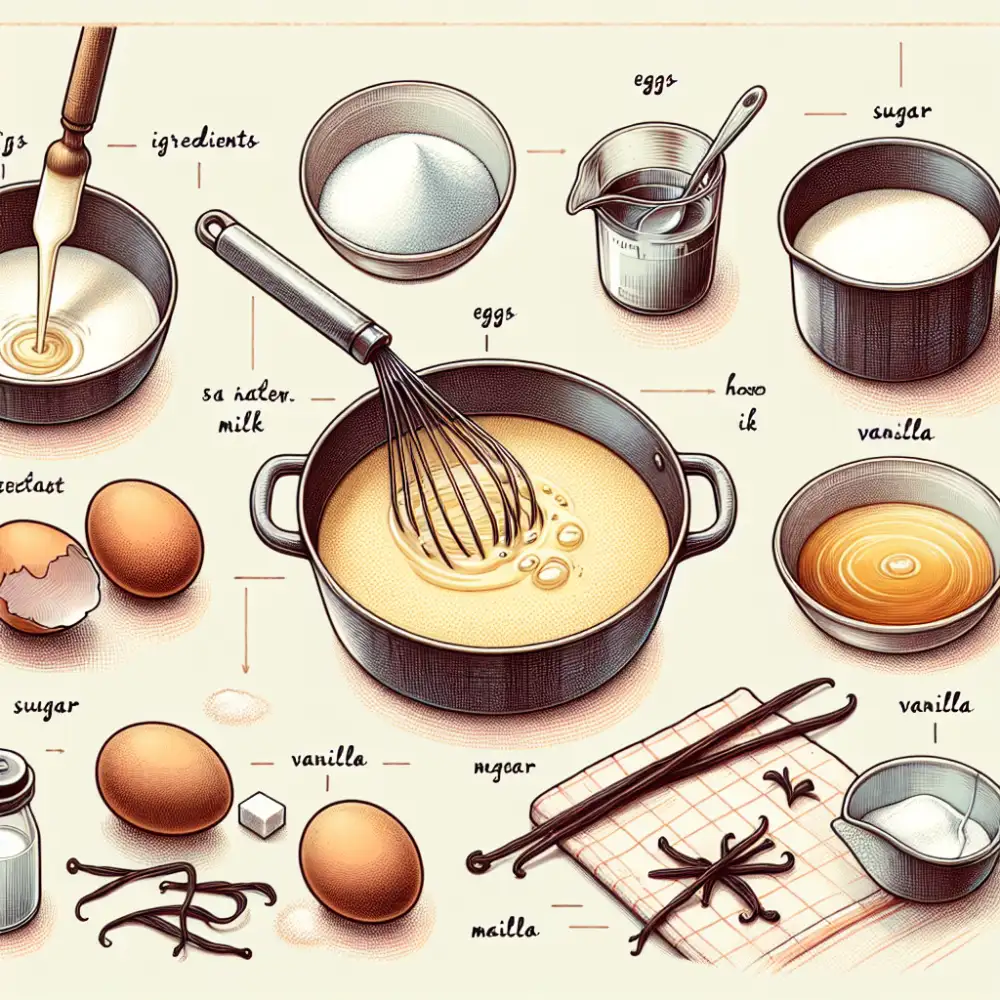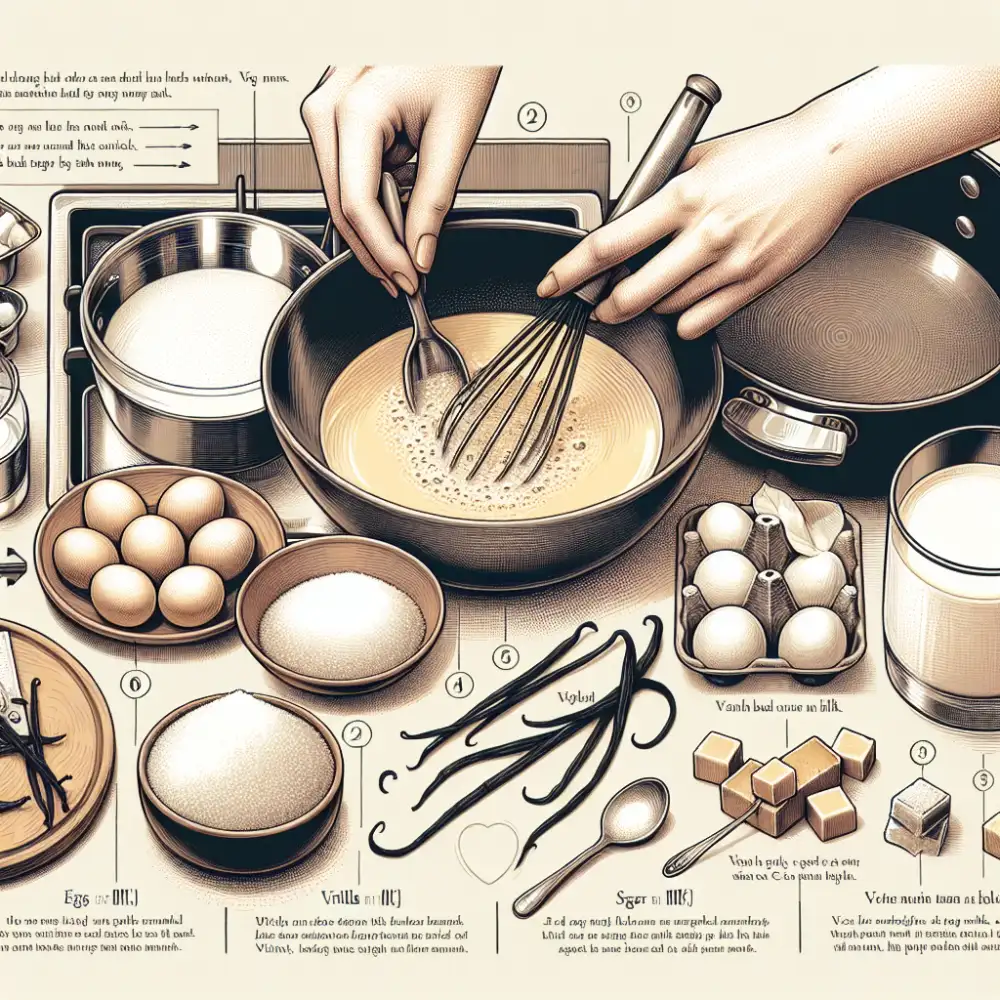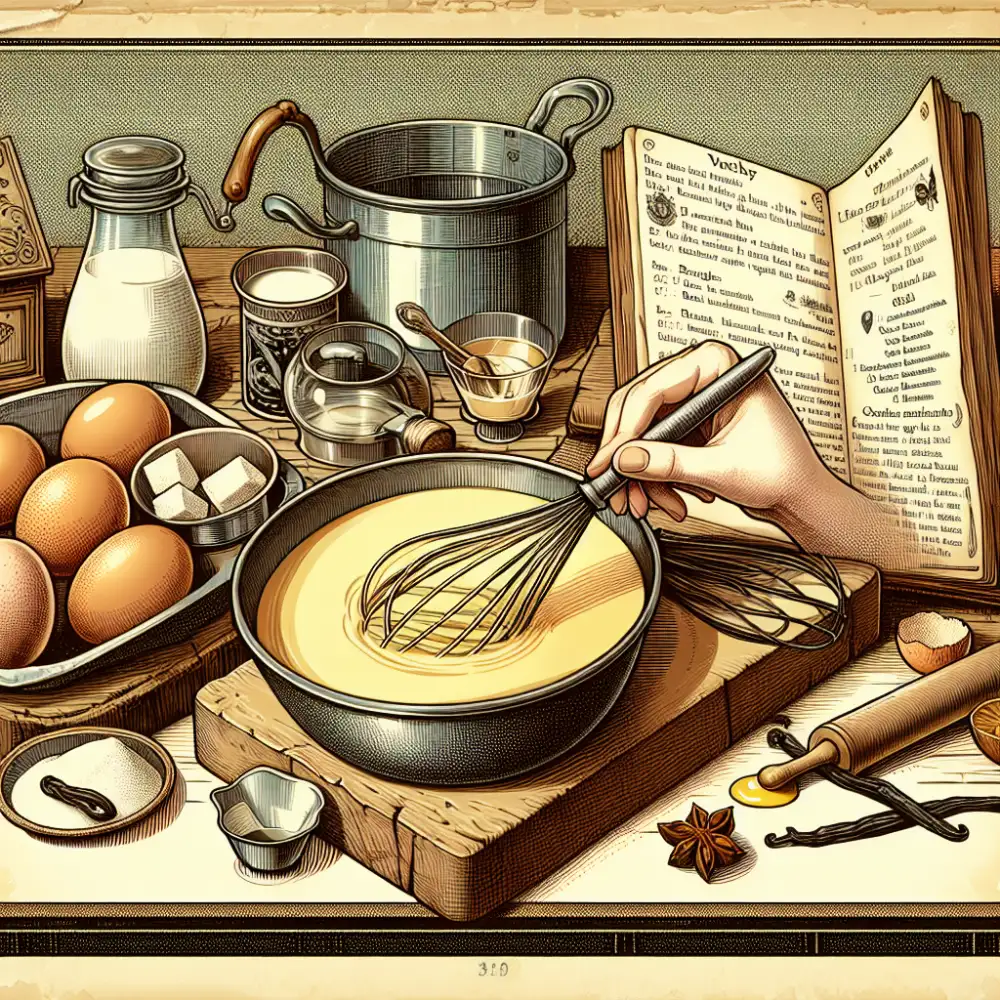Deliciously Creamy: A Step-by-Step Guide on How to Make Custard

- Ingredients for Custard
- Step-by-Step Instructions for Making Custard
- Heat the Milk
- Mix the Eggs, Sugar, and Cornstarch
- Temper the Egg Mixture
- Combine the Milk and Egg Mixture
- Cook the Custard
- Add Flavorings (optional)
- Chill and Serve
- Tips and Variations for Making Custard
- Choosing the Right Milk
- Using Different Sweeteners
- Experimenting with Flavorings
- Serving Suggestions
Custard is a classic dessert that has been enjoyed for centuries. It is a rich and creamy dish that can be served on its own or used as a base for other desserts. Custard is made by combining milk or cream with eggs, sugar, and flavorings, then cooking it until thickened. The result is a smooth and velvety texture that melts in your mouth. Custard can be enjoyed warm or chilled, and it pairs well with fruits, cakes, pies, and more. Whether you're a beginner in the kitchen or an experienced cook, making custard is a delightful way to indulge in a sweet treat.
Ingredients for Custard
To make a deliciously creamy custard, you will need the following ingredients:
1. Milk: Use whole milk for a rich and creamy texture. You can also use low-fat or non-dairy milk alternatives if preferred.
2. Eggs: Fresh eggs are essential for custard as they provide the thickening agent and contribute to its smoothness.
3. Sugar: Granulated white sugar is commonly used to sweeten custard. However, you can also experiment with alternative sweeteners like honey or maple syrup.
4. Cornstarch: This acts as a stabilizer and helps thicken the custard.
Optional Ingredients:
1. Vanilla Extract: Adding a splash of vanilla extract enhances the flavor of the custard.
2. Nutmeg or Cinnamon: These spices can be sprinkled on top of the custard for an extra touch of warmth and aroma.
3. Fruit Puree or Chocolate: For added flavor variations, you can mix in fruit puree such as strawberry or raspberry, or even melted chocolate into the custard mixture before cooking.
Note: The quantities of these ingredients may vary depending on your desired serving size and personal taste preferences.
Step-by-Step Instructions for Making Custard
These step-by-step instructions will help you create a deliciously creamy custard that can be enjoyed on its own or used as a base for various desserts and pastries.
Heat the Milk
To make a deliciously creamy custard, the first step is to heat the milk. Start by pouring the desired amount of milk into a saucepan and placing it over medium heat. It's important to stir the milk occasionally to prevent it from scorching or forming a skin on top. Heating the milk helps to infuse it with flavor and creates a smooth texture in the custard. Be careful not to let the milk boil, as this can cause it to curdle. Once the milk is hot and steaming, you're ready to move on to the next step in creating your delectable custard.
Mix the Eggs, Sugar, and Cornstarch
To make a deliciously creamy custard, the next step after heating the milk is to mix the eggs, sugar, and cornstarch. In a separate bowl, whisk together the eggs until they are well beaten. Gradually add in the sugar and continue whisking until the mixture becomes smooth and pale yellow in color. Then, sift in the cornstarch and whisk again until it is fully incorporated. The cornstarch helps to thicken the custard and gives it a smooth texture. Make sure there are no lumps remaining in the mixture before moving on to the next step of tempering.

| Feature | Stovetop Custard | Baked Custard |
|---|---|---|
| Cooking Method | Cooked on stovetop in a saucepan | Baked in the oven in a water bath |
| Texture | Smooth, creamy, pourable | Soft, silky, spoonable |
| Ideal for | Trifles, fillings, sauces | Standalone dessert, crème brûlée base |
| Cooking Time | ~15-20 minutes | ~45-60 minutes |
Temper the Egg Mixture
Tempering the egg mixture is a crucial step in making custard to ensure a smooth and creamy texture. To temper the eggs, start by whisking them together with sugar and cornstarch until well combined. Then, slowly pour a small amount of hot milk into the egg mixture while continuously whisking. This gradual addition of hot liquid helps to raise the temperature of the eggs without causing them to curdle. Repeat this process a few times, gradually increasing the amount of hot milk each time, until about half of the milk has been added. Once tempered, you can safely combine the egg mixture with the remaining hot milk without worrying about curdling.
Combine the Milk and Egg Mixture
Once the milk has been heated, it's time to combine it with the egg mixture. Slowly pour a small amount of the hot milk into the bowl containing the eggs, sugar, and cornstarch. Whisk continuously while pouring to prevent the eggs from curdling. This process is known as tempering and helps to gradually raise the temperature of the eggs without scrambling them.
Continue whisking and slowly add the remaining hot milk to the egg mixture until well combined. This step ensures that all ingredients are evenly distributed throughout the custard base. The resulting mixture should be smooth and creamy in texture.
By combining the milk and egg mixture properly, you create a cohesive blend that will form a rich and velvety custard when cooked. It's important to take your time during this step to ensure a smooth consistency in your final product.
Cook the Custard
To cook the custard, place the saucepan with the milk and egg mixture over medium heat. Stir continuously with a wooden spoon or whisk to prevent lumps from forming. The custard will gradually thicken as it heats up. Be patient and keep stirring until it reaches a smooth and creamy consistency.

It's important to note that custard should never be boiled, as this can cause it to curdle or develop a grainy texture. Keep the heat low and steady, allowing the custard to gently simmer. This process usually takes around 10-15 minutes, but cooking times may vary depending on your stove and the desired thickness of the custard.
As you cook the custard, pay close attention to its texture. It should coat the back of a spoon without dripping off too quickly. To test if it's done, run your finger across the back of the spoon – if a clear line remains without any liquid running into it, your custard is ready.
Once cooked, remove the saucepan from heat immediately to prevent overcooking. Remember that residual heat can continue thickening the custard even after removing it from direct heat.
Now that your custard is cooked to perfection, you can proceed to add optional flavorings such as vanilla extract or grated nutmeg for an extra touch of deliciousness. Stir well to incorporate these flavors evenly throughout the custard.
After adding flavorings, allow the custard to cool slightly before transferring it into individual serving dishes or a large bowl for chilling in the refrigerator. Cover with plastic wrap directly touching its surface to prevent a skin from forming while chilling.
Chill your creamy homemade custard in the refrigerator for at least 2 hours or until completely cold before serving. This will enhance its flavor and give it a luscious texture.
Remember that freshly made custards are best enjoyed within 2-3 days of preparation for optimal taste and quality. So, make sure to plan accordingly and savor every spoonful of this delectable dessert.
Add Flavorings (optional)
Adding flavorings to your custard can take it to the next level and create a truly delightful dessert. While custard is delicious on its own, you can enhance its taste by incorporating various flavorings. Here are some popular options:
- Vanilla: The most classic and widely used flavoring for custard is vanilla. You can use vanilla extract or scrape the seeds from a vanilla bean and add them to the custard mixture. This will infuse a rich and aromatic taste into your custard.
- Chocolate: For all the chocolate lovers out there, adding cocoa powder or melted chocolate to your custard will give it a decadent twist. Make sure to whisk in the cocoa powder or melted chocolate smoothly with the other ingredients for a luscious chocolatey flavor.
- Citrus Zest: Adding citrus zest such as lemon, orange, or lime can add a refreshing and tangy note to your custard. Simply grate the zest of your desired citrus fruit and mix it into the custard mixture before cooking.
- Spices: Experimenting with spices like cinnamon, nutmeg, cardamom, or even ginger can bring warmth and depth of flavor to your custard. Add these spices in small amounts according to your preference, ensuring they complement rather than overpower the delicate taste of the custard.
Remember that when adding flavorings, moderation is key. Start with small amounts and gradually adjust according to your taste preferences. Be mindful of balancing flavors so that they harmonize well with the creamy base of the custard.


By adding these optional flavorings, you can customize your custard recipe and create unique variations that cater to different palates and occasions. Whether you prefer a classic vanilla-infused custard or want to experiment with bold flavors like chocolate or spices, these additions will undoubtedly elevate your culinary experience.
So go ahead, get creative with your flavor choices, and enjoy the delightful world of custard!
Chill and Serve
Once the custard has finished cooking, it's time to chill and serve this delectable treat. Carefully remove the saucepan from the heat and allow the custard to cool slightly. Then, transfer it to a clean bowl or individual serving dishes. Cover with plastic wrap, making sure it touches the surface of the custard to prevent a skin from forming.
Place the custard in the refrigerator and let it chill for at least 2 hours or until completely set. The chilling process allows the flavors to meld together and gives the custard a smooth and creamy texture.
When you're ready to serve, remove the custard from the refrigerator and uncover. Optionally, you can garnish with fresh fruit, a sprinkle of cinnamon or nutmeg, or a dollop of whipped cream for an extra touch of indulgence.
Custard can be enjoyed on its own as a delightful dessert or used as a filling for pies, tarts, pastries, or cakes. Its versatility makes it a perfect accompaniment to many desserts.
Remember that leftover custard should be stored in an airtight container in the refrigerator and consumed within 2-3 days for optimal freshness.
Now that you've mastered the art of making homemade custard, get creative with your flavor combinations and serving ideas. Let your culinary imagination run wild!
Tips and Variations for Making Custard
1. Choosing the Right Milk: For a rich and creamy custard, opt for whole milk or even heavy cream. Skim or low-fat milk can result in a thinner consistency.
2. Using Different Sweeteners: While traditional custards are made with granulated sugar, you can experiment with alternative sweeteners like honey, maple syrup, or even brown sugar for a unique flavor twist.

3. Experimenting with Flavorings: Get creative with your custard by adding various flavorings such as vanilla extract, almond extract, citrus zest, or even spices like cinnamon or nutmeg. Remember to adjust the quantities according to taste.
4. Serving Suggestions: Custard is incredibly versatile and can be enjoyed on its own or used as a base for other desserts. Serve it warm over fruit pies, cakes, or crumbles. Alternatively, chill it and serve it topped with fresh berries, caramel sauce, or a sprinkle of cocoa powder.
These tips will help you create a custard that suits your preferences and adds an extra touch of deliciousness to your culinary creations!
Choosing the Right Milk
Choosing the right milk is crucial when making custard. Whole milk is the most commonly used and provides a rich and creamy texture. It has a higher fat content which adds to the smoothness of the custard. If you prefer a lighter option, you can use low-fat or skim milk, but keep in mind that the custard may not be as rich. Avoid using non-dairy alternatives like almond or soy milk as they may not have the same consistency and flavor as traditional dairy milk. Ultimately, the choice of milk will depend on your personal preference and dietary needs.
Using Different Sweeteners
One of the great things about making custard is that you can experiment with different sweeteners to achieve your desired level of sweetness. While traditional custard recipes call for granulated sugar, there are other options available that can add a unique twist to your dessert.
One popular alternative sweetener is honey. Not only does honey provide a natural sweetness, but it also adds a subtle floral flavor to the custard. When using honey as a sweetener, it's important to note that its flavor can vary depending on the type and source of honey you choose. For a milder taste, opt for clover or wildflower honey, while darker varieties like buckwheat or chestnut honey will impart a stronger flavor.
Another option is maple syrup, which lends a rich and distinct taste to the custard. Maple syrup pairs particularly well with fall-inspired flavors such as cinnamon or nutmeg. When substituting maple syrup for sugar in your custard recipe, use approximately ¾ cup of maple syrup for every 1 cup of sugar called for.
For those looking for a healthier alternative, stevia is an excellent choice. Stevia is a plant-based sweetener that contains zero calories and has no impact on blood sugar levels. It provides sweetness without any bitter aftertaste and can be used in powdered or liquid form. Keep in mind that stevia is much sweeter than sugar, so adjust the amount accordingly when using it in your custard recipe.


When experimenting with different sweeteners in your custard, remember to taste as you go and make adjustments according to your preference. Whether you choose honey, maple syrup, or stevia, each sweetener will bring its own unique flavor profile to your creamy dessert creation.
Experimenting with Flavorings
One of the best things about making custard is the ability to experiment with different flavorings. While classic vanilla custard is always a crowd-pleaser, there are countless other options to explore. Here are a few ideas to get you started:
- Citrus Zest: Add a burst of freshness by incorporating citrus zest into your custard. Lemon, orange, or lime zest can add a tangy and aromatic twist to the creamy base.
- Spices: Warm spices like cinnamon, nutmeg, or cardamom can infuse your custard with cozy flavors. Just a pinch of these spices can elevate the taste and make it perfect for fall or winter desserts.
- Extracts: Besides vanilla extract, there are plenty of other extracts you can use to flavor your custard. Almond extract adds a subtle nuttiness, while coconut extract lends a tropical touch.
- Liqueurs: For an adult twist, consider adding a splash of liqueur to your custard. Popular choices include rum, brandy, or even coffee liqueur for an extra kick.
Remember to start with small amounts when experimenting with flavorings and adjust according to your taste preferences. The key is to enhance the custard's flavor without overpowering it. So go ahead and get creative – there's no limit to the delicious variations you can create!
Serving Suggestions
Once you have made a deliciously creamy custard, it's time to think about how to serve it. Here are some serving suggestions that will take your custard to the next level:
1. Classic Custard: Serve the custard on its own in individual ramekins or bowls. You can sprinkle a little nutmeg or cinnamon on top for added flavor.
2. Fruit Toppings: Top your custard with fresh fruits like berries, sliced peaches, or mangoes. The combination of the creamy custard and the juicy fruits creates a delightful contrast in textures and flavors.
3. Caramel Drizzle: Drizzle some warm caramel sauce over the custard for an indulgent treat. The sweet caramel adds a rich and decadent touch to the creamy custard.
4. Crème Brûlée: Turn your custard into a fancy dessert by sprinkling some sugar on top and using a kitchen torch to caramelize it until it forms a crispy crust. This adds an irresistible crunch to the smooth custard.

5. Custard Pie: Use your homemade custard as a filling for pies. Pour it into a pre-baked pie crust and let it set in the refrigerator before serving. Top with whipped cream or fresh fruit for an elegant dessert.
6. Trifle: Layer cubes of cake, fruit, and custard in a glass dish to create a beautiful trifle dessert. Repeat the layers and finish with whipped cream on top for an impressive presentation.
Remember, when serving custard, make sure it is chilled properly for at least two hours before serving to allow it to set completely. Enjoy this versatile dessert on its own or get creative with toppings and presentations!
In conclusion, making custard is a delightful and rewarding experience. With just a few simple ingredients and steps, you can create a creamy and luscious dessert that will impress your family and friends. Whether you choose to enjoy it on its own or use it as a base for other desserts, custard is sure to satisfy your sweet tooth. So why not give it a try? Follow this step-by-step guide and explore the endless possibilities of custard-making. Get ready to indulge in the velvety goodness of homemade custard!
Published: 15. 02. 2024
Category: Food



